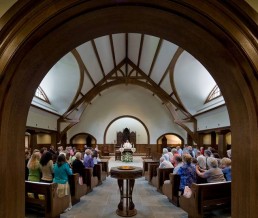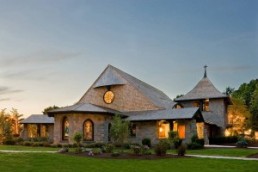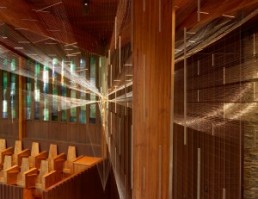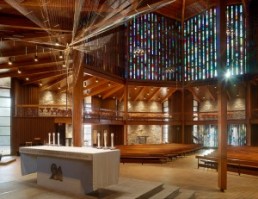Faith & Form magazine and The Interfaith Forum on Religion, Art and Architecture (IFRAA) announced that Church of St. Gregory the Great on the campus of Portsmouth Abbey won a 2014 Honor Award in the category of Religious Architecture: Restoration; and Our Lady of Mercy Chapel on the campus of Salve Regina University won a 2014 international award in the category of Religious Architecture: New Facilities. Northeast Collaborative Architects (NCA) orchestrated the restoration of Church of St. Gregory the Great. Robert A.M. Stern Architects designed Our Lady of Mercy Chapel and NCA served as the Architect of Record.
Winning entries are published in the Winter 2014 Awards Issue of Faith & Form magazine. An exhibition of award-winning projects will be displayed at the 2015 National Convention of the American Institute of Architects in Atlanta in June 2015. The winning projects were chosen by the design awards jury, chaired by Terry Byrd Eason, which convened at The Duke Endowment on July 10-11 in Charlotte, N.C. The Annual Religious Art and Architecture Design Awards program was founded in 1978 with the goal of honoring the best in architecture, liturgical design and art for religious spaces. The program offers five primary categories for awards: Religious Architecture, Liturgical/Interior Design, Sacred Landscape, Religious Arts, and Unbuilt Work.
Church of St. Gregory the Great
Architect Pietro Belluschi collaborated with sculptor Richard Lippold, craftsman George Nakashima, and glass designer Henry Lee Willett in 1960 to create an icon of ecclesiastical architecture at Portsmouth Abbey in Portsmouth, Rhode Island. Church of St. Gregory the Great presides over the private high school campus on a platform and symbolizes the Benedictine Monks’ cultivation of learning, liturgy, and conservation. The octagonal church with a 28-foot clerestory draws inspiration from San Vitale built in Ravenna, Italy in the 1500s. Stone walls, redwood board and batten, stained glass, and copper roofs reflect Pacific Northwestern, Scandinavian, and Japanese design precedents.
The church’s original engineering lacked the lateral stability needed to withstand New England’s harsh coastal climate. Needed restoration was not apparent to casual observers; but chronic leaking that compromised the structural integrity worried the monks and students who prayed there daily. As a result, Portsmouth Abbey launched a seven-year restoration campaign. The design team reinforced the structure, refurbished the 60-foot spire, improved energy efficiency, and added new chandeliers without altering Belluschi’s Modernist aesthetic.
The clerestory presented the greatest challenge. Extensive water damage warranted that all 136 of the 28-foot clerestory frames be replaced. Old growth timber was shipped to the site from Vancouver; then kiln dried, milled, primed, installed and painted. To ensure the original glass pattern was not lost, 2,960 pieces of glass that were mounted between the framework were labeled, cataloged, removed, cleaned, and reassembled. Structural deficiencies also threatened the sculpture. Lippold wove Trinity into space with 22,000 feet of golden wire sewn through aluminum bars on their way from the cross to the church’s columns and ceiling. The 2,000 wires and 5,000 joints make 11 triangular arrays that radiate from the cross suspended 10 feet above the altar across 12,000 cubic feet. Trinity was dusty, corroded and collapsing. Art restorers treated the arrays like boat sails, clamping their ends, then cutting and lowering them. They replaced all the wires on a giant loom, returned to the church, and remounted them all.
Our Lady of Mercy Chapel
Founded by the Sisters of Mercy and chartered in 1934, Salve Regina University is a co-educational Catholic university that first opened its doors in 1947 when the opportunity arose for it to take over one of Newport’s great Gilded Age “cottages”: the Goelet family’s Ochre Court (Richard Morris Hunt, 1891), which today serves as the school’s main administration building. For more than sixty years Salve got along with a make-do chapel installed in what had been a ballroom in Ochre Court—though the room, with its over-the-top gilded frippery, always seemed at odds with the Sisters of Mercy’s mission of aid and education for the poor. Our new chapel, nestled into a small wood at the center of campus, was designed as the physical representation of the University’s spiritual mission, which combines a continuing Catholic tradition with open and ecumenical outreach to people of all faiths.
Our Lady of Mercy Chapel is very much in the tradition of New England country churches, here deployed with a Roman Catholic inflection. The Chapel presented us with various design obstacles including reconciling the historic geometries of the campus, which we addressed by providing three entrance points: a ceremonial entrance off of Ochre Point Avenue; a campus entrance oriented toward the campus buildings of the Catherine Lorillard Wolfe estate; and the campus ministry (staff) entrance on axis with Ochre Court.
The main sanctuary, which accommodates 250 worshipers, is carefully planned to support the specific sacramental functions of a dedicated Roman Catholic chapel—altar, pulpit, and baptismal font, along with accommodation for musical ministry. The vaulted ceiling in the chapel reaches 34 feet in height and is punctuated on its east and west sides by large eyebrow dormers to bring daylight in. The Rodgers Interfaith Prayer Room across the narthex from the chapel offers members of the university’s diverse community a sacred space for prayer and quiet reflection. This room is set with five leaded opalescent glass windows by noted late 19th-century artist John La Farge that were originally installed in a chapel at the nearby Caldwell House (1890), now demolished. The Mercy Center for Spiritual Life on the lower level provides a conference room, classrooms, and offices. The stair tower that links to the lower level is topped with a belfry and steeple, creating a visual landmark for the chapel bells that gather the Salve community.




